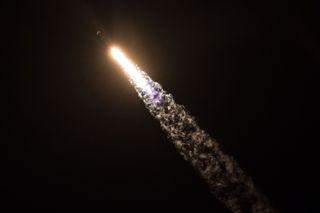SpaceX Says Falcon 9 Rocket Performed as Expected During Zuma Launch
As media reports swirl around the ultimate fate of the U.S. government's secret Zuma mission, which launched atop a SpaceX rocket Sunday (Jan. 7), the private spaceflight company says its Falcon 9 booster performed as expected during the launch.
"For clarity: after review of all data to date, Falcon 9 did everything correctly on Sunday night," SpaceX President and Chief Operating Officer Gwynne Shotwell said in a statement. "If we or others find otherwise based on further review, we will report it immediately.
"Information published that is contrary to this statement is categorically false," Shotwell continued. "Due to the classified nature of the payload, no further comment is possible." [See amazing photos of SpaceX's Zuma launch]
Shotwell's comments come amid media speculation, including from The Wall Street Journal and Ars Technica, suggesting that the top-secret payload may have fallen back to Earth. The Wall Street Journal reported that lawmakers and congressional staffers had been briefed on the alleged mission failure, according to government and industry officials, and indicated that there might have been a failed separation between the payload and the rocket's second stage. That type of failure could potentially have occurred after a successful Falcon 9 launch.

The Zuma mission is SpaceX's third classified launch, and details on the payload are sparse: It was procured by the defense contractor Northrop Grumman, and it was intended for low-Earth orbit. However, the government agency in charge has not been revealed. SpaceX's other classified missions — which launched an X-37B space plane for the U.S. Air Force and an NROL-76 spy satellite for the National Reconnaissance Office — did include those basic details.
The Zuma launch was supposed to occur in November but was delayed so that SpaceX could inspect data from testing on another customer's protective nose cone, called the payload fairing.
According to Eric Berger of Ars Technica, Zuma was assigned a number in the satellite catalog Space-Track.org, which implies it was able to make at least one orbit of Earth — but it could have still been attached to the second stage and failed to detach after that point. Berger noted that the payload adapter connecting the stage to the payload and fairing was provided by Northrop Grumman, so a potential separation problem could track back to that company's failure. A Northrop Grumman representative told Space.com the company cannot comment on classified missions.
Get the Space.com Newsletter
Breaking space news, the latest updates on rocket launches, skywatching events and more!
Because the Falcon 9 functioned correctly, Shotwell said, future SpaceX launches should not be delayed, including the highly anticipated first launch of the company's Falcon Heavy rocket.
"Since the data reviewed so far indicates that no design, operational or other changes are needed, we do not anticipate any impact on the upcoming launch schedule," she said in the statement. "Falcon Heavy has been rolled out to launchpad LC-39A for a static fire later this week, to be followed shortly thereafter by its maiden flight. We are also preparing for an F9 launch for [the communications satellite operator] SES and the Luxembourg Government from SLC-40 in three weeks."
The Falcon Heavy rocket, which is currently slated to launch in late January, will have the greatest payload capacity of any U.S. rocket since NASA's Saturn V. Its core stage was first test-fired in May.
Email Sarah Lewin at slewin@space.com or follow her @SarahExplains. Follow us @Spacedotcom, Facebook and Google+. Original article on Space.com.
Join our Space Forums to keep talking space on the latest missions, night sky and more! And if you have a news tip, correction or comment, let us know at: community@space.com.

Sarah Lewin started writing for Space.com in June of 2015 as a Staff Writer and became Associate Editor in 2019 . Her work has been featured by Scientific American, IEEE Spectrum, Quanta Magazine, Wired, The Scientist, Science Friday and WGBH's Inside NOVA. Sarah has an MA from NYU's Science, Health and Environmental Reporting Program and an AB in mathematics from Brown University. When not writing, reading or thinking about space, Sarah enjoys musical theatre and mathematical papercraft. She is currently Assistant News Editor at Scientific American. You can follow her on Twitter @SarahExplains.
